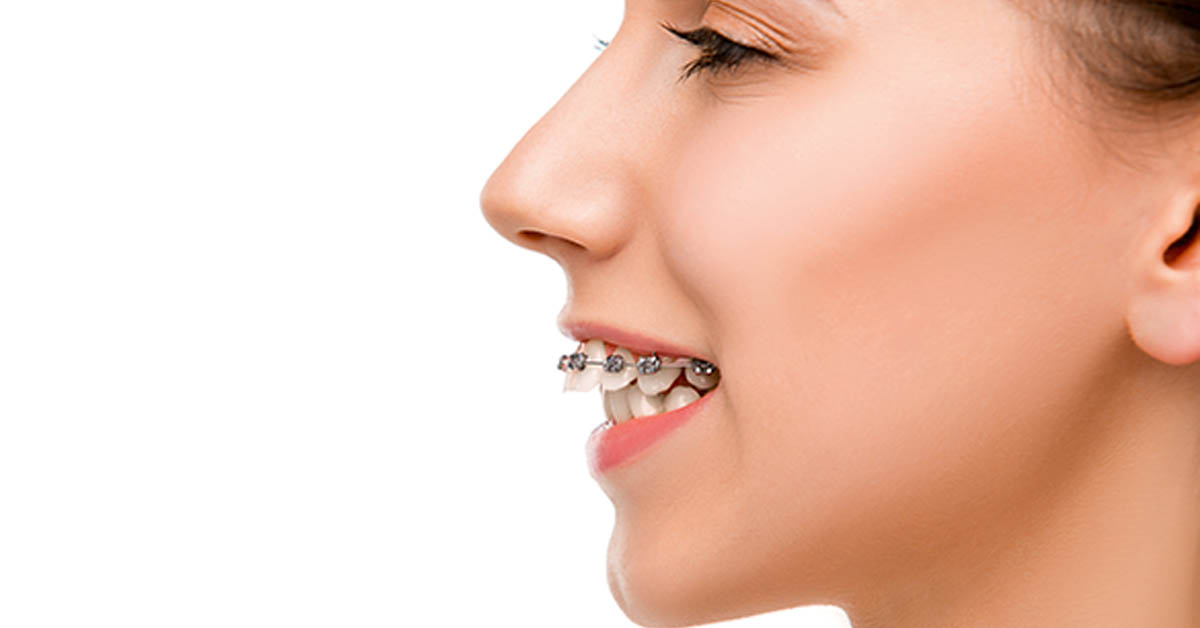
How Do Braces Fix Overbites?
By Dr. Tyler Coles – Premier Orthodontics
Table of Contents
A perfect smile is not just about straight, pearly whites . . . it’s also about having a well-aligned bite.
But what if your upper teeth stick out beyond your lower teeth more than they should? This dental condition, known as an overbite, can lead to more than just an unattractive smile. From speech problems to gum disease, overbites can significantly impact your overall oral health. Fortunately, understanding the causes, types, and treatment options for overbites can help you make informed decisions about your dental care for you or your child.
In this comprehensive guide, we’ll delve into the world of overbites, exploring the differences between dental and skeletal overbites, why early intervention is often helpful, and the various treatment options available to correct an overbite. Say goodbye to your overbite worries and hello to a healthy, confident smile!
What Is An Overbite? Definition and Causes
Before we start talking about how to fix overbites, let’s first define what an overbite is….
What most people call an overbite, orthodontists actually call “Overjet” – which basically means that the top teeth stick out much farther than the bottom teeth.
So, what exactly is this dental condition called an overbite or “overjet” in orthodontic terms? Well, it’s when your upper teeth stick out past your lower teeth. A tiny overbite of 1 to 3 millimeters is pretty normal, but anything more than 3 millimeters and you might need to see an orthodontist. Overbites are pretty common in the world of orthodontics, and the way they’re fixed can vary depending on how serious the overbite is and the age of the patient.
Braces are the go-to tool that orthodontists use to tackle overbites. They help to get the upper and lower teeth back in line. Whether it’s the old-school metal braces or the modern clear aligners, orthodontic treatment can really improve your smile and get your teeth working better by fixing an overbite.
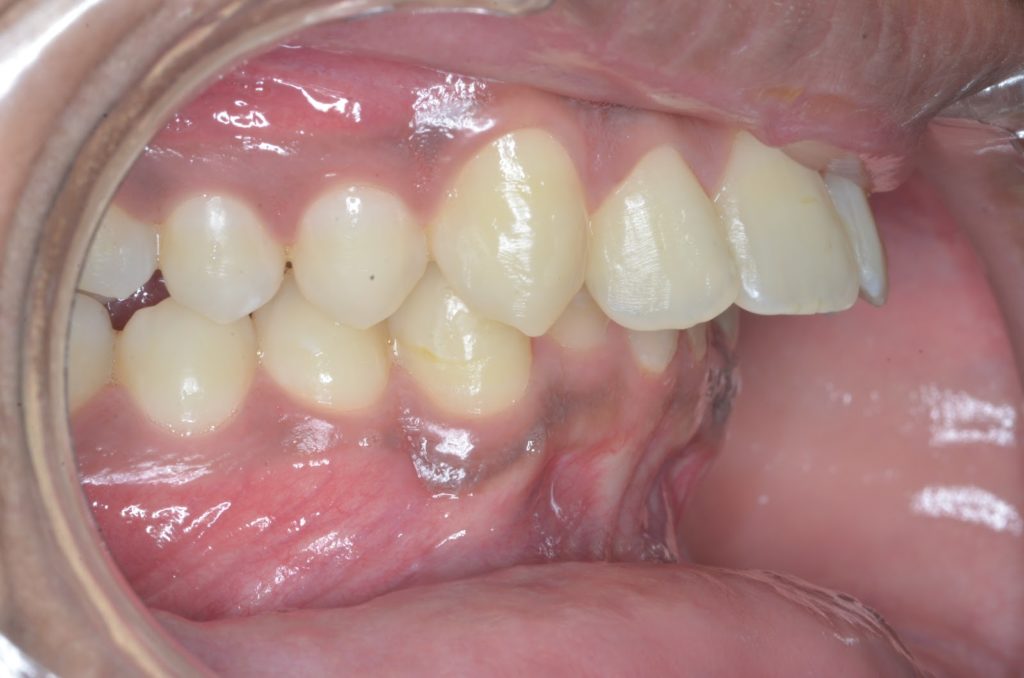
Causes of Overbites
While genetics play a significant role in the development of overbites by impacting the dimensions and form of the jaw and teeth, habits such as thumb-sucking and tongue thrusting can also contribute to this dental issue. Thumb-sucking can result in an overbite by pushing the upper teeth forward and the lower teeth backward. Similarly, tongue thrusting can lead to an overbite by pushing the upper teeth forward and the lower teeth backward, as well as causing tooth loss if the tongue is excessively pushing against the teeth.
Pinpointing the root cause of an overbite is key to determining the most beneficial treatment plan. Whether it’s a dental overbite caused by tooth positioning or a skeletal overbite due to jawbone structure, a customized treatment plan can help you achieve a healthy, well-aligned smile.
Types of Overbites: Dental and Skeletal
Alright, let’s break down overbites into two main categories: dental and skeletal. Dental overbites? They’re all about how your teeth are positioned. Skeletal overbites, on the other hand, are all down to the structure of your jawbone. Knowing the difference between these two is super important when it comes to picking the best treatment plan for your individual case.
In the next few sections, we’re going to dive into the nitty-gritty of both dental and skeletal overbites. We’ll look at what makes them different, and the various treatment options available for each type. So, stick with us!
Dental Overbite
A dental overbite occurs when the upper teeth protrude past the lower teeth. It may be caused by a disruption in dental development, like overcrowding of teeth, the loss of back teeth, or poor oral habits. This type of overbite is primarily a result of tooth positioning, which can be corrected with braces or clear aligners.
The most typical method of rectifying a dental overbite is through braces, which can range in cost from $3,000 to $7,000. Braces will usually be done in combination with one of the following treatment options:
Rubber bands
Herbst appliance
Forsus springs
Extractions
The time frame for correcting an overbite with braces varies depending on the individual, but more severe cases may take several years to rectify.
Skeletal Overbite
So, a skeletal overbite is a kind of misalignment that occurs when the jawbone grows in a way it’s not supposed to, causing the teeth and jaws to develop incorrectly. This kind of overbite is all about how your jawbones are aligned, and fixing it might need surgery or some special appliances.
In serious cases of skeletal overbites, the best approach is usually a mix of oral surgery and comprehensive orthodontic treatment. This combo is often recommended for moderate to severe overbites, where braces alone might not be enough to sort out the problem. And just a heads up – dealing with a skeletal overbite early on can really make a difference in how successful the treatment is.
Signs and Symptoms of Overbites
Individuals with overbites may experience a range of signs and symptoms, including:
Difficulty chewing
Speech problems
Facial pain
Altered facial appearance
An overbite may also lead to speech problems due to its influence on tongue placement and utilization.
Addressing an overbite early can help prevent these complications and improve overall oral health. By seeking timely orthodontic treatment, patients can enhance their quality of life and enjoy a confident, well-aligned smile.
Treatment Options for Overbite Correction
There are various treatment options available for overbite correction, each tailored to the specific needs and severity of the overbite. These options include:
Braces with rubber bands
Braces with a Herbst appliance
Braces with Forsus springs
Braces with extractions
Braces with jaw surgery
Being aware of the benefits and potential drawbacks of each treatment option is crucial for making a well-informed decision about your overbite correction. In the following sections, we’ll explore each treatment option in detail, providing insights into their effectiveness, as well as the factors to consider when choosing the right approach for your needs.
Fixing Overbites With Braces and Rubber Bands
Braces and rubber bands can be employed to rectify mild overbites by exerting pressure to move the teeth into their correct alignment. Connecting a rubber band between the upper and lower teeth over time pulls the top teeth back and the bottom teeth forward, gradually correcting the overbite.
This approach has proven successful in rectifying mild overbites, resulting in improved smiles, as evidenced by a patient who decided to wear braces and use rubber bands for treatment. Following the orthodontist’s instructions and maintaining good oral hygiene throughout the treatment process is pivotal for optimal results.
The patient shown in this picture is a good example of a mild overbite – you can see that her top teeth stick out a bit compared to the lower teeth, but overall they look pretty good.

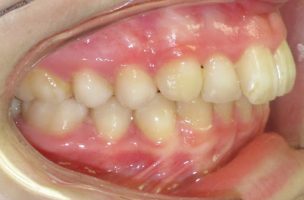
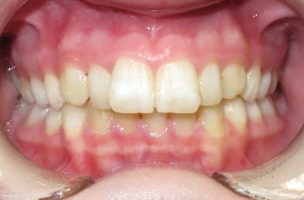
For this type of overbite, a combination of braces and elastics was used to help bring the top teeth back into a better alignment.
As you can see in this video, by connecting a rubber band between the upper and lower teeth, over time the top teeth will be pulled back and the bottom teeth will be pulled forward.
With the patient we showed earlier, you can see that braces with rubber bands helped to fix her overbite and give her a great smile. Check out her before and after overbite photos below.






Fixing Overbites With Braces and a Herbst Appliance
For younger children with moderate to severe overbites, braces, and a Herbst appliance can be an effective solution. The Herbst appliance is bonded onto the teeth and works by posturing the patient’s lower jaw into a forward position. Over time, the teeth will begin to move in the direction of the forward-positioned jaw, and as the child grows, their jaws will move into a more correct position.
The Herbst appliance is usually placed for about a year, followed by braces. This combination of treatments can result in a fully corrected overbite and a significantly improved facial profile for younger patients.
The patient shown in this picture is a good example of a younger child with a more severe overbite.
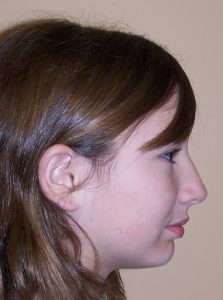
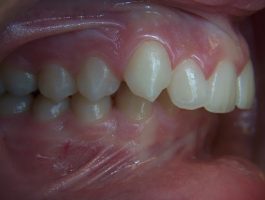
This patient was a great candidate for bite correction using a herbst appliance. The animation below demonstrates what a herbst appliance looks like when applied by an orthodontist
Essentially, this appliance is bonded onto the teeth, and it works by posturing the patient’s lower jaw into a forward position.
When the jaw is held in this forward position for a long enough period of time, the teeth will begin to move in this direction. The best part is that as the child grows, their jaws will move into a more correct position as well.
This appliance is usually placed for about a year, and then is followed by braces.
You can see that in the patient we showed earlier, she got her overbite fixed and her profile is much improved.

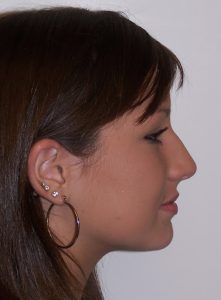

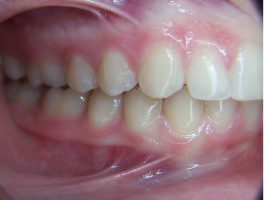
Fixing Overbites With Braces and Forsus Springs
For older teenagers and adults with moderate overbites, an appliance called Forsus Springs is usually recommended. Forsus Springs are typically placed after about a year of wearing braces. The Forsus Springs appliance works by compressing the spring, pushing the bottom teeth forward and the top teeth back, effectively correcting the overbite.
Forsus Springs correction is more predictable and usually leads to more efficient correction than elastics alone. This treatment option is especially beneficial for older patients whose jaws have finished growing and may not respond as effectively to a Herbst appliance.
You can see in this video exactly how the appliance works.
First, you compress the spring, pushing the bottom teeth forward and the top teeth back. This appliance works very similarly to elastics, but the correction is more predictable and usually leads to more efficient correction.
You can see in this patient shown, that she was a teenager with a moderate overbite. Braces and Forsus springs were used to get a great result and completely correct her moderate overbite.


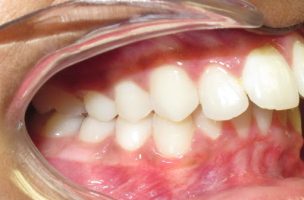
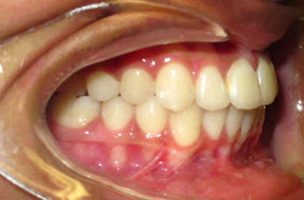
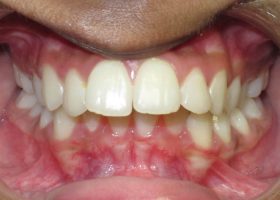
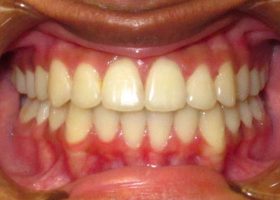
Fixing Overbites With Braces and Extractions
In cases of severe overbite, braces combined with extractions may be necessary to correct the bite. The process usually involves extracting the first bicuspid (or first premolar teeth) and then pulling the front six teeth back into that extraction space.
Once the space is closed, it’s not noticeable that teeth were ever removed, the bite fits together properly, and the overbite should be corrected. This treatment option can result in a dramatic improvement in both the appearance and function of the teeth.
This patient is a good example.

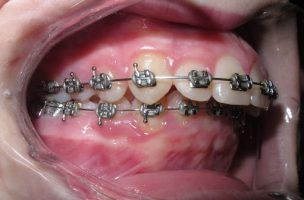
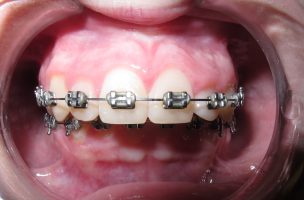
This patient had actually started braces at another orthodontist’s office, and she had been wearing rubber bands with her braces for a couple of years. When she transferred to our office we felt that her overbite was too severe to be fixed with rubber bands alone.
Due to the severity of her bite, we recommended that two permanent teeth get removed or extracted on her upper arch in order to fix her bite.
This short animation will demonstrate how taking out two teeth on the upper arch, and then closing the space, can fix a severe overbite and help reduce the protrusion of the front teeth.
You can see in this animation that we will usually have the first bicuspid (or first premolar teeth) extracted, and then pull the front 6 teeth back into that extraction space.
Once this space is closed, you won’t be able to tell that teeth were ever removed. The bite will fit together properly and the overbite should be corrected.
Going back to our patient, she had two teeth on her upper arch extracted. We closed that space by pulling her front teeth back. By the time we were done, she had a beautiful smile, no spaces, and her overbite was completely corrected.



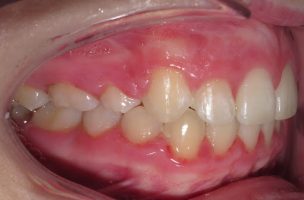

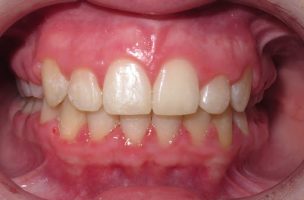
Click below to watch our video on the entire process of fixing overbites with braces.
Fixing Overbites With Braces and Jaw Surgery
For severe skeletal overbites that cannot be corrected with braces alone, a combination of braces and jaw surgery may be necessary. Correcting an overbite through braces and jaw surgery involves a combination of orthodontic treatment and orthognathic surgery, where braces are employed to arrange the teeth and ready them for surgery, while jaw surgery is conducted to reposition the jaw and rectify the overbite.
Watch the animation below to see how orthognathic surgery can help fix overbites.
This approach is usually suggested for severe overbites, where traditional orthodontic treatments may not be sufficient to correct the underlying issue. By combining braces and jaw surgery, patients can achieve a healthy, well-aligned bite and a significant improvement in their facial appearance.

For more details about orthognathic surgery watch the video below.
The Importance of Early Intervention and Timely Treatment
Early intervention and prompt treatment of overbites can prevent complications and enhance overall oral health. Initiating orthodontic treatment for overbite can enhance health issues such as headaches, migraines, and jaw pain. Moreover, optimal bite positions have been associated with improved sleep, enhanced digestion, increased self-esteem, and a general improvement in overall health and well-being.
For children, early intervention with treatments such as a palate expander can help accommodate crowded teeth in a jaw of limited size and set the stage for successful orthodontic treatment later in life. By addressing overbites early, patients can prevent more severe issues from developing and enjoy a lifetime of healthy, confident smiles.
Costs and Insurance Coverage for Overbite Treatment
The costs associated with overbite treatment can vary depending on the specific treatment plan and the severity of the overbite. Braces, which are a common form of treatment, can range from $3,000 to $7,000, while Invisalign can cost around $5,000 on average. Surgical correction of an overbite can also incur additional costs. It is advised to consult with an orthodontist to obtain an accurate estimate of the costs involved.
Insurance coverage for overbite treatment may vary depending on the insurance plan and the treatment plan in question. It is advised to consult with your insurance provider in order to ascertain what type of coverage is available, helping you make a well-informed decision about your dental care.
Post-Treatment Care and Maintenance
Upon completion of overbite correction treatment, post-treatment care and maintenance become vital for preserving the results and preventing a relapse. Retainers are often utilized to sustain the outcomes of overbite treatment and guard against the overbite reoccurring. Wearing a retainer at night can serve to safeguard the teeth prior to the overbite issue being addressed.
By adhering to the orthodontist’s instructions for post-treatment care, including proper oral hygiene and regular dental check-ups, patients can ensure their teeth remain healthy, well-aligned, and beautiful for years to come.
Potential Complications of Untreated Overbites
Leaving an overbite untreated can result in a host of complications that may impact your overall oral health and quality of life. Potential consequences include:
Tooth damage
Jaw pain
Speech impediments
Self-esteem issues
Moreover, untreated overbites can lead to more severe issues, such as:
Premature aging
Facial wrinkles
Headaches
Jaw tension
Neck stress
Poor posture
Small appearing chins
Slurred speech
The lower teeth may emerge into the upper palate
Addressing an overbite early and seeking timely orthodontic treatment to fix an overbite can help prevent these complications, improve overall oral health, and restore confidence in your smile.
How Can I Tell if Me or My Child Needs Braces to Fix an Overbite?
If you think you or your child may need braces to correct an overbite, the best place to start is by getting a free consultation with an orthodontist in your area.
Getting with Braces in Phoenix, Chandler, Maricopa, and Casa Grande
Premier Orthodontics has 6 locations providing braces and Invisalign in Phoenix, Chandler, Gilbert, Maricopa, Casa Grande, and Glendale as well as the surrounding areas.
Schedule your free consultation for braces or Invisalign or read our comprehensive guide to the cost of braces . (We are very transparent about our process and our pricing, as you’ll see in this guide.)
Schedule a Free Braces Consultation For You or Your Child
Thinking about getting started with braces?
You can schedule a 100% free consultation and find out if clear braces the best choice for you.
Whether you’re thinking about braces for kids, braces for an adult, or even Invisalign, we’ve got you covered!
Click below to learn how you can get started with braces for as low as $89/month.
Table of Contents

Dr. Tyler Coles joined his brother’s practice in 2012 and since then, the practice has expanded to six locations and over 20,000 patient lives transformed throughout Arizona.
Dr. Coles has also co-authored two books with his brother ( “More Than Straight Teeth! A Parent’s Guide to Orthodontics” and “Start Smiling Now! What Every Parent Needs to Know About Orthodontics”). Request a free copy of “More that Straight Teeth“ to better understand the process of braces.


